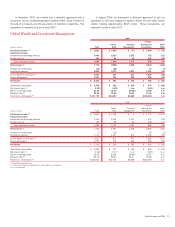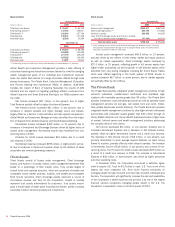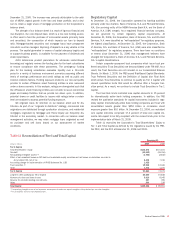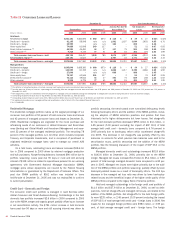Bank of America 2006 Annual Report Download - page 63
Download and view the complete annual report
Please find page 63 of the 2006 Bank of America annual report below. You can navigate through the pages in the report by either clicking on the pages listed below, or by using the keyword search tool below to find specific information within the annual report.
December 31, 2005. The increase was primarily attributable to the addi-
tion of MBNA, organic growth in the loan and lease portfolio, and a deci-
sion to retain a larger share of mortgage production on the Corporation’s
balance sheet.
The strength of our balance sheet is a result of rigorous financial and
risk discipline. Our core deposit base, which is a low cost funding source,
is often used to fund the purchase of incremental assets (primarily loans
and securities), the composition of which impacts our loan to deposit
ratio. Mortgage-backed securities and mortgage loans have prepayment
risk which must be managed. Repricing of deposits is a key variable in this
process. The capital generated in excess of capital adequacy targets and
to support business growth, is available for the payment of dividends and
share repurchases.
ALCO determines prudent parameters for wholesale market-based
borrowing and regularly reviews the funding plan for the bank subsidiaries
to ensure compliance with these parameters. The contingency funding
plan for the banking subsidiaries evaluates liquidity over a 12-month
period in a variety of business environment scenarios assuming different
levels of earnings performance and credit ratings as well as public and
investor relations factors. Funding exposure related to our role as liquidity
provider to certain off-balance sheet financing entities is also measured
under a stress scenario. In this analysis, ratings are downgraded such that
the off-balance sheet financing entities are not able to issue commercial
paper and backup facilities that we provide are drawn upon. In addition,
potential draws on credit facilities to issuers with ratings below a certain
level are analyzed to assess potential funding exposure.
We originate loans for retention on our balance sheet and for dis-
tribution. As part of our “originate to distribute” strategy, commercial loan
originations are distributed through syndication structures, and residential
mortgages originated by Mortgage and Home Equity are frequently dis-
tributed in the secondary market. In connection with our balance sheet
management activities, we may retain mortgage loans originated as well
as purchase and sell loans based on our assessment of market
conditions.
Regulatory Capital
At December 31, 2006, the Corporation operated its banking activities
primarily under two charters: Bank of America, N.A. and FIA Card Services,
N.A. (the surviving entity of the MBNA America Bank N.A. and the Bank of
America, N.A. (USA) merger). As a regulated financial services company,
we are governed by certain regulatory capital requirements. At
December 31, 2006, the Corporation, Bank of America, N.A. and FIA Card
Services, N.A. were classified as “well-capitalized” for regulatory purposes,
the highest classification. At December 31, 2005, the Corporation, Bank
of America, N.A. and Bank of America, N.A. (USA) were also classified as
“well-capitalized” for regulatory purposes. There have been no conditions
or events since December 31, 2006 that management believes have
changed the Corporation’s, Bank of America, N.A.’s and FIA Card Services,
N.A.’s capital classifications.
Certain corporate sponsored trust companies which issue trust pre-
ferred securities (Trust Securities) are deconsolidated under FIN 46R. As a
result, the Trust Securities are not included on our Consolidated Balance
Sheets. On March 1, 2005, the FRB issued Risk-Based Capital Standards:
Trust Preferred Securities and the Definition of Capital (the Final Rule)
which allows Trust Securities to continue to qualify as Tier 1 Capital with
revised quantitative limits that would be effective after a five-year tran-
sition period. As a result, we continue to include Trust Securities in Tier 1
Capital.
The Final Rule limits restricted core capital elements to 15 percent
for internationally active bank holding companies. In addition, the FRB
revised the qualitative standards for capital instruments included in regu-
latory capital. Internationally active bank holding companies are those with
consolidated assets greater than $250 billion or on-balance sheet
exposure greater than $10 billion. At December 31, 2006, our restricted
core capital elements comprised 17.3 percent of total core capital ele-
ments. We expect to be fully compliant with the revised limits prior to the
implementation date of March 31, 2009.
Table 11 reconciles the Corporation’s Total Shareholders’ Equity to
Tier 1 and Total Capital as defined by the regulations issued by the FRB,
the FDIC, and the OCC at December 31, 2006 and 2005.
Table 11 Reconciliation of Tier 1 and Total Capital
December 31
(Dollars in millions) 2006 2005
Tier 1 Capital
Total Shareholders’ equity
$135,272
$101,533
Goodwill
(65,662)
(45,354)
Nonqualifying intangible assets
(1)
(3,782)
(2,642)
Effect of net unrealized losses on AFS debt and marketable equity securities and net losses on derivatives recorded in
Accumulated OCI, net of tax
6,430
7,316
Accounting change for implementation of FASB Statement No. 158
1,428
–
Trust securities
(2)
15,942
12,446
Other
1,436
1,076
Tier 1 Capital
91,064
74,375
Long-term debt qualifying as Tier 2 Capital
24,546
16,848
Allowance for loan and lease losses
9,016
8,045
Reserve for unfunded lending commitments
397
395
Other
203
238
Total Capital
$125,226
$ 99,901
(1) Nonqualifying intangible assets of the Corporation are comprised of certain core deposit intangibles, affinity relationships, and other intangibles.
(2) Trust Securities are net of unamortized discounts.
Bank of America 2006
61
























